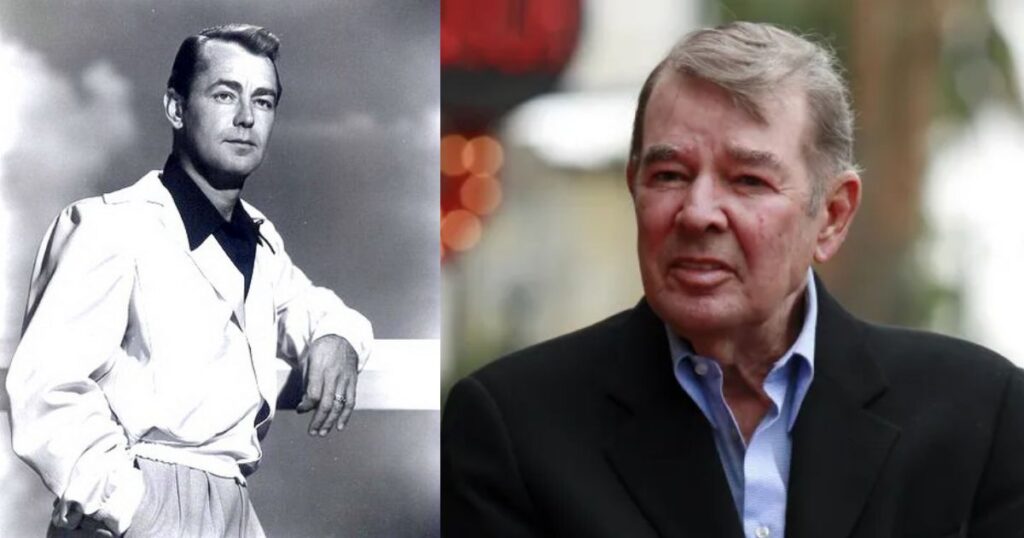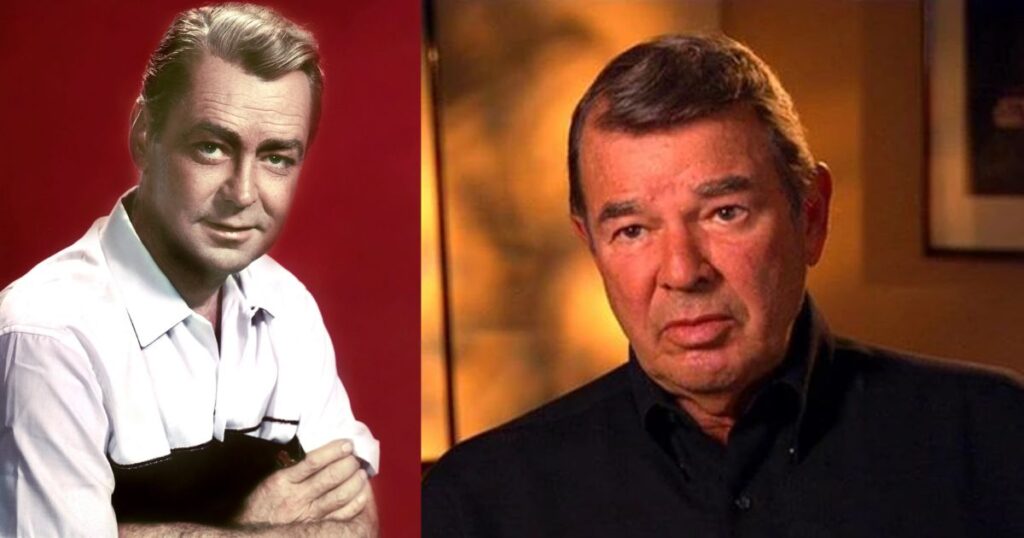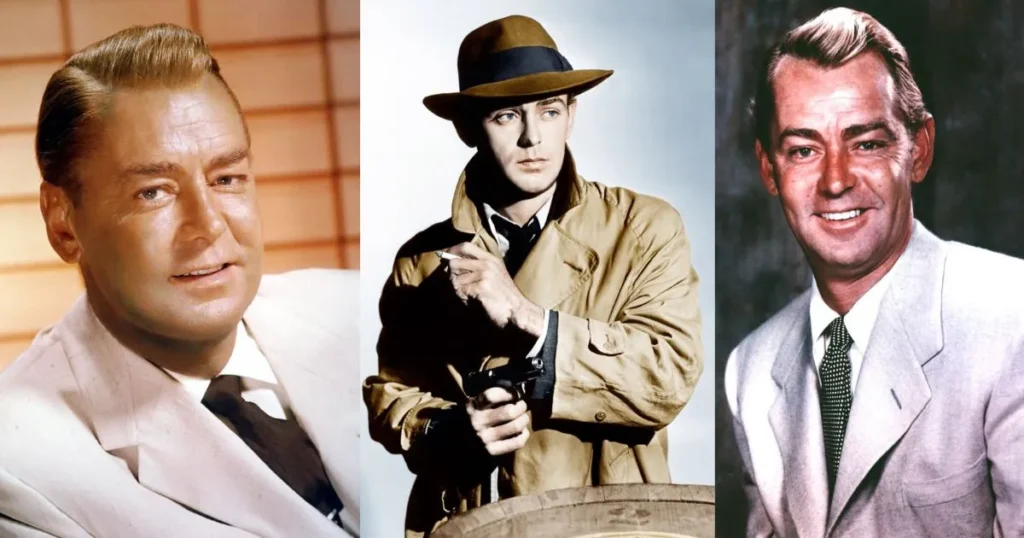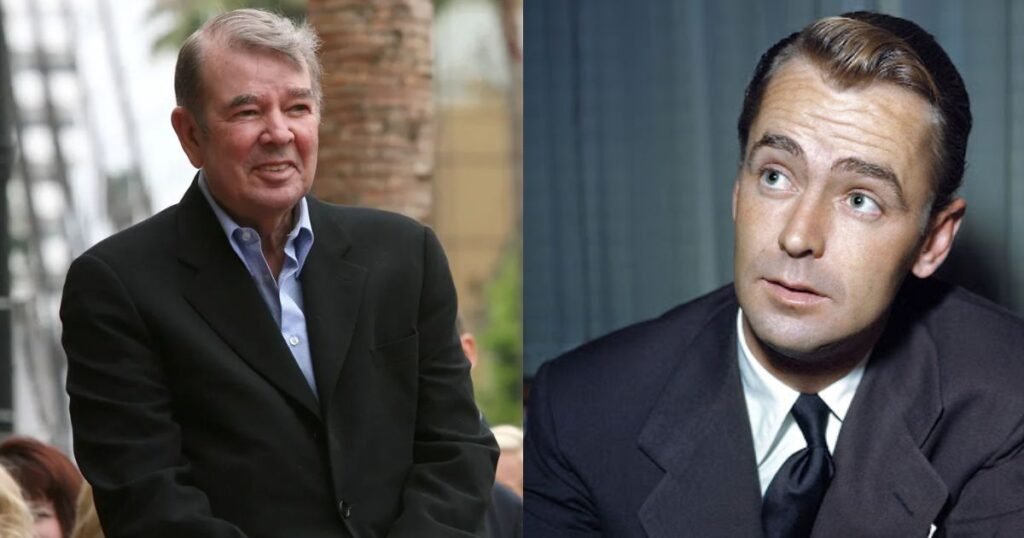At the time of his death in 1964, Alan Ladd’s net worth was $200,000 – equivalent to roughly $1.7 million today. This might surprise many, given his status as one of Hollywood’s biggest stars of the 1940s and 1950s.
The story behind this number reveals much about Hollywood’s golden age, the studio system’s financial realities, and one man’s journey from poverty to stardom and his subsequent struggles.
Who was Alan Ladd?
Alan Ladd was more than just another Hollywood face. Despite standing only 5’6″, this Arkansas-born actor commanded the screen with an intensity that made him one of Paramount Pictures’ most bankable stars.
Rising from a grip at Warner Bros. Studios to Hollywood stardom, Ladd’s breakthrough came in 1942’s “This Gun for Hire.” His portrayal of a complex hitman with a conscience captivated audiences and established his trademark stoic, understated acting style.
His defining role came in 1953’s “Shane,” where he played a mysterious gunfighter. This performance didn’t just earn critical acclaim – it cemented his place in cinema history and became his most lucrative project.
Early Life: From Hardship to Hollywood
Born September 3, 1913, in Hot Springs, Arkansas, Ladd’s early years were marked by poverty. His father’s death when Alan was just four left the family struggling to make ends meet.
Moving frequently with his mother, they eventually landed in California. Here, young Alan attended North Hollywood High School, where he discovered his talents in swimming and diving – skills that would later help him maintain the physical presence needed for Hollywood.
Living in cheap apartments and boarding houses taught Ladd the value of money early on. This background would influence his later financial decisions, creating a complex relationship with wealth that followed him throughout his career.
Career and Achievements: A Star is Born
Ladd’s rise in Hollywood reads like a classic underdog story. Starting as a grip, he worked his way through small radio roles before landing his breakthrough in “This Gun for Hire.” His partnership with Veronica Lake became legendary, producing hits like “The Blue Dahlia” and “The Glass Key.”
During his peak years at Paramount, Ladd commanded top salaries and earned critical acclaim. His performance in “Shane” brought six Academy Award nominations to the film and significantly boosted his earning power.
Beyond individual films, Ladd’s achievements included a star on the Hollywood Walk of Fame and the Golden Globe Henrietta Award. His induction into the American National Cowboy and Western Heritage Museum’s Hall of Great Western Performers recognized his lasting impact on the genre.
Sources of Income: Beyond the Silver Screen
While movie salaries formed his primary income, Ladd diversified his earnings wisely. In 1954, he launched Jaguar Productions, taking greater control of his projects and potential profits.
Real estate investments, particularly in Palm Springs and Los Angeles, provided additional income streams. Ladd also maintained steady earnings through radio work and strategic endorsements.
However, the Hollywood studio system’s structure meant stars often received less than their apparent worth. Complex contracts and studio accounting practices affected actors’ actual takeaways from box office successes.
Assets and Lifestyle: Living the Hollywood Dream
Ladd’s success brought the expected trappings of Hollywood stardom, though he maintained a relatively modest lifestyle compared to his peers. His Palm Springs property became his sanctuary, a retreat from the pressures of Hollywood.
While he enjoyed fine cars and maintained an impressive wardrobe fitting his star status, Ladd wasn’t known for extravagant spending. His Los Angeles residence served practical purposes, keeping him close to the studios where he worked.
Personal accounts suggest Ladd valued comfort over flash. His gun collection reflected both his Western film persona and genuine interest, while his continued passion for swimming spoke to his unpretentious roots.
Alan Ladd Net Worth at Death: A Closer Look

The reported $200,000 net worth at Ladd’s death in 1964 requires context. Some sources suggest the figure might have been closer to $1.3 million, highlighting the challenges in accurately assessing celebrity wealth of that era.
Hollywood’s financial landscape differed dramatically from today’s entertainment industry. Stars lacked the merchandising deals, backend profits, and diverse income streams that modern actors enjoy. The studio system’s grip on talent often limited long-term wealth accumulation.
Understanding Ladd’s final net worth means considering factors like career decline, personal struggles, and the era’s economic realities. While $200,000 might seem modest, it represents significant wealth for 1964, roughly equivalent to $1.7 million in today’s money.
Net Worth Over the Years: A Fluctuating Fortune
Tracking Ladd’s wealth through his career reveals a fascinating financial journey. His early years saw steady growth, from grip wages to radio earnings to increasingly substantial film salaries.
The 1940s brought his peak earning period. As one of Paramount’s top stars, Ladd commanded significant fees per picture. The establishment of Jaguar Productions in 1954 marked an attempt to secure greater financial control.
However, the late 1950s saw declining opportunities and earnings. This period coincided with changing audience tastes and Ladd’s personal challenges, affecting his ability to maintain his earlier income levels.
Personal Life: Behind the Scenes
Ladd’s marriages reflected different phases of his financial journey. His first marriage to Marjorie Jane “Midge” Harrold came during his struggling years. Their son, Alan Ladd Jr., would later achieve his own success as a film executive.
His second marriage to Sue Carol, his agent, proved more stable and financially beneficial. Carol’s industry expertise helped guide Ladd’s career decisions. Together they had two children, Alana and David Ladd.
Despite professional success, Ladd battled personal demons. Depression and alcoholism affected not just his career but his financial decisions. These struggles provide crucial context for understanding his ultimate net worth.
Controversies and Financial Issues: The Darker Side of Stardom
Ladd’s career decline coincided with increasing personal troubles. The shift from leading man to supporting roles impacted both his earning potential and self-esteem.
Hollywood’s notoriously complex accounting practices likely affected his long-term wealth accumulation. Like many stars of his era, Ladd faced challenges navigating the business side of show business.
His investments, including Jaguar Productions, saw mixed results. While real estate holdings provided some stability, the entertainment industry’s uncertainties took their toll.
Impact of Personal Struggles on Financial Health
Ladd’s battle with depression and alcohol affected more than his career trajectory. These challenges influenced his business decisions and ability to manage wealth effectively.
Medical expenses and career interruptions took their toll. The stigma surrounding mental health in his era meant fewer support systems existed for stars facing personal demons.
These struggles highlight the complex relationship between personal well-being and financial health in the entertainment industry.
The Business Side of Stardom: Analyzing Ladd’s Financial Decisions
Ladd’s approach to business revealed a mix of traditional star management and forward-thinking strategies. Creating Jaguar Productions showed business acumen unusual for actors of his era.
His real estate investments, particularly in growing areas like Palm Springs, demonstrated financial foresight. These properties provided stability when film roles became scarce.
However, like many stars, Ladd missed opportunities in merchandising and television that could have expanded his wealth. The entertainment industry’s rapid evolution outpaced many golden age actors’ business models.
Hollywood Economics: Then vs Now

The studio system of Ladd’s era operated vastly differently from today’s entertainment industry. Stars worked under strict contracts that limited their negotiating power and profit participation.
Modern actors often earn through multiple revenue streams – merchandising, streaming rights, and production deals. Ladd’s era offered fewer opportunities for wealth diversification.
Understanding this context helps explain why even major stars of the 1940s and 1950s often ended their careers with modest wealth compared to today’s standards.
Investment Strategies and Missed Opportunities
While Ladd made solid investments in real estate, he might have benefited from more diverse investment strategies. The post-war economic boom offered opportunities he didn’t fully exploit.
His focus on traditional investments reflected his conservative approach to money, shaped by his poverty-stricken childhood.
The evolution of entertainment industry economics suggests that different strategies might have preserved more wealth for his later years.
Cultural Impact vs. Financial Success
Ladd’s enduring influence on film culture stands in stark contrast to his final net worth. His portrayal in “Shane” continues to influence Western films and actor performances.
The disconnect between cultural impact and financial outcomes raises questions about how we measure success in entertainment. Some of Hollywood’s most influential figures didn’t die wealthy.
This paradox highlights the complex relationship between artistic achievement and financial reward in the entertainment industry.
The Role of Public Image in Financial Success
Ladd’s carefully managed public image contributed to his success but also created personal pressures. Modern stars face similar challenges with greatly increased scrutiny.
Social media and instant news coverage have transformed how stars manage their public personas. This affects both earning potential and career longevity.
The balance between public image and personal authenticity remains a crucial factor in sustained success.
Preserving Wealth in Hollywood: Lessons from Ladd’s Era
The challenges Ladd faced in maintaining wealth reflect broader issues in entertainment industry finance. Many stars of his generation struggled with similar financial outcomes.
Modern entertainers can learn from these historical examples. The importance of diversification, professional financial management, and long-term planning becomes clear through Ladd’s story.
The cyclical nature of entertainment careers makes financial planning crucial, a lesson as relevant today as it was in Ladd’s time.
Lasting Impact on Hollywood Economics
Ladd’s career and financial journey influenced later generations of actors and their approach to business. His son, Alan Ladd Jr., applied these lessons in his successful career as a studio executive.
The evolution from pure talent contracts to more complex entertainment deals partly resulted from experiences like Ladd’s.
Modern stars benefit from the hard lessons learned during Hollywood’s golden age about financial management and career sustainability.
Legacy Beyond Numbers

Ladd’s true legacy transcends his final net worth. His influence on film, particularly in “Shane,” continues to inspire new generations of actors and filmmakers.
His son Alan Ladd Jr.’s success as a Hollywood executive suggests the family’s entertainment industry savvy extended beyond one generation. This legacy represents value beyond mere financial measurements.
The lessons from Ladd’s financial journey offer insights into Hollywood’s evolution. From the rigid studio system to modern entertainment business models, his story highlights both progress and persistent challenges.
Read Also: Sachi Parker Net Worth: Unveiling the Wealth of Shirley Temple’s Daughter
FAQ’s
How did Alan Ladd primarily earn his money?
Most money came from Paramount Pictures film roles. He added income through radio work, real estate investments, and his production company.
What was Alan Ladd’s highest-earning year?
His peak earnings came in the late 1940s when he starred in his biggest Paramount hits. “Shane” in 1953 was likely his most profitable single film.
Did Alan Ladd leave a significant inheritance to his family?
He left about $200,000 at death, modest for a Hollywood star. His assets were mainly in real estate and personal property.
How does Alan Ladd Net Worth at Death compare to other stars of his era?
His final worth was lower than many stars of his time. Career decline and personal struggles in the 1950s affected his wealth.
Did Alan Ladd have any successful business ventures outside of acting?
He created Jaguar Productions in 1954 and invested in Palm Springs real estate. His property investments did well, though his production company saw limited success.
Conclusion
Alan Ladd’s journey from poverty to Hollywood stardom ended with a $200,000 net worth at his death in 1964. That’s about $1.7 million today. It’s a story of ups and downs.
Starting as a studio grip, he became one of Paramount’s biggest stars. His role in “Shane” made him a legend. But despite his fame, money troubles followed.
He made smart moves like starting Jaguar Productions and buying real estate. Yet personal battles with depression and alcohol took their toll.
His legacy goes beyond money. His son became a successful film executive, and his influence on Western films lives on. Ladd’s story shows how Hollywood’s golden age stars faced unique financial challenges.

Hello, I’m Amelia Eva a dynamic author at TrendOxygen.com, specializing in Tech, Lifestyle, Business, Entertainment, and Sports. Passionate about uncovering the latest trends, my articles offer a broad range of topics, delivering insightful and captivating content for readers.
With an exceptional ability to simplify complex concepts, I make my writing approachable for everyone. Follow me on TrendOxygen.com for fresh insights and the latest updates on what’s trending in the world of technology, lifestyle, and beyond.


